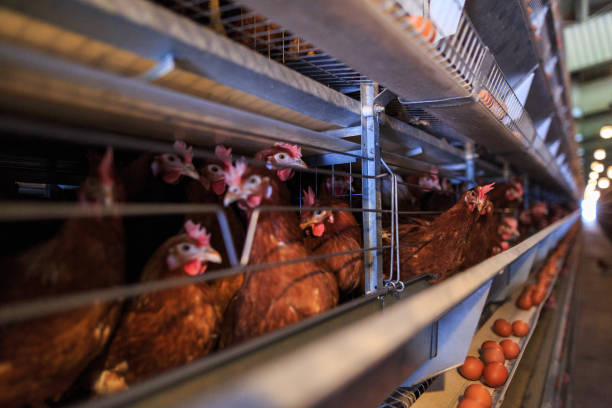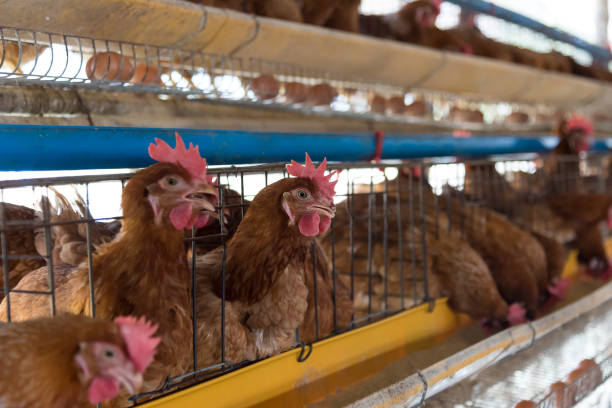
Maximize Egg Production: Find the Best Poultry Cages for Your Farm
Maximize Egg Production: Find the Best Poultry Cages for Your Farm
For poultry farmers focused on optimizing egg production, the selection of poultry cages is a pivotal decision. The right cage system can significantly impact hen health, egg quality, space utilization, and overall farm efficiency. This article delves into the essential aspects of choosing the best poultry cages to maximize egg production on your farm.
Understanding the Impact of Poultry Cages on Egg Production
Poultry cages are more than just housing; they are a central component of a successful egg-laying operation. The design, materials, and features of a cage directly influence several key factors:
Hen Welfare: A comfortable and safe environment reduces stress, which is crucial for consistent egg laying.
Egg Quality: Proper cage design minimizes egg breakage, maintains cleanliness, and facilitates easy collection.
Space Efficiency: Optimized cage layouts allow for a higher density of birds without compromising their well-being.
Labor Efficiency: Automated systems for feeding, watering, and egg collection reduce labor costs and improve productivity.
Disease Control: Well-designed cages facilitate better hygiene and reduce the risk of disease outbreaks.
Types of Poultry Cages for Egg-Laying Hens
The market offers a variety of poultry cage systems, each with its advantages and disadvantages. Understanding these options is critical for making an informed decision:
Traditional Battery Cages: These are the most common type of cage, typically arranged in rows and tiers. They offer good space efficiency and relatively low upfront costs. However, they have come under scrutiny for animal welfare concerns due to limited space and lack of enrichment.
Enriched Cages: Enriched cages are designed to improve hen welfare by providing more space and amenities such as perches, nesting areas, and scratching pads. While they address some welfare concerns, they can be more expensive and require more space than traditional battery cages.
Aviary Systems: Aviary systems are cage-free environments that allow hens to roam freely within a designated area. They offer the highest level of welfare but require more space and management. They also present challenges in terms of egg collection, bird management, and disease control.
Layer Cage Systems for Small Farms: Designed for small-scale poultry businesses, space efficiency and simplicity are key with these.
A-Frame Layer Cages: Known for their sturdy construction and adequate space, A-frame cages offer a balanced approach to hen welfare and production efficiency.
H-Frame Layer Cages: Maximizing space, H-frame cages incorporate vertical tiers for high-density farming without compromising hen comfort.
Key Factors to Consider When Choosing Poultry Cages
Selecting the right poultry cages depends on various factors, including your farm’s size, budget, and production goals, as well as the preferences of your target market (e.g., cage-free eggs). Here are some key considerations:
Hen Welfare: Prioritize cages that provide adequate space, ventilation, and enrichment. Consider the impact on hen behavior and stress levels.
Egg Quality: Look for cages that minimize egg breakage and maintain cleanliness through proper design and materials.
Cage Material and Durability: The cage material should be non-toxic, corrosion-resistant, and easy to clean. Common materials include galvanized steel and plastic. Durability is essential for long-term cost-effectiveness.
Ventilation and Climate Control: Proper ventilation is crucial for maintaining air quality and temperature. Choose cages that provide adequate airflow and consider integrating them with a climate control system.
Feeding and Watering Systems: Automated feeding and watering systems can significantly reduce labor costs and ensure consistent nutrient intake. Look for systems that are easy to maintain and prevent feed wastage.
Egg Collection Systems: Automated egg collection systems can minimize egg breakage and reduce labor costs. Choose a system that is reliable and easy to operate.
Manure Management Systems: Efficient manure removal is essential for maintaining hygiene and reducing odor. Consider automated systems that remove manure regularly and prevent it from accumulating in the cages.
Space Utilization: Optimize cage layout to maximize the number of birds per square foot without compromising their well-being.
Regulatory Compliance: Ensure that the cages comply with all relevant regulations and animal welfare standards.
Cost-Effectiveness: Consider the upfront cost, operating costs, and lifespan of the cages. Choose a system that provides the best value for your investment.
Detailed Analysis of Poultry Cage Designs
Let’s delve deeper into the specific features and benefits of different cage designs:
Traditional Battery Cages: These cages are typically made of wire mesh and arranged in rows and tiers. They are relatively inexpensive and easy to install, but they offer minimal space and enrichment for hens. Traditional battery cages are becoming less popular due to animal welfare concerns.
Enriched Cages: These cages have a larger footprint than traditional battery cages and include features such as perches, nesting areas, and scratching pads. These features allow hens to express their natural behaviors and improve their welfare. Enriched cages are a good compromise between traditional battery cages and cage-free systems.
Aviary Systems: Aviary systems offer the highest level of welfare for hens, as they allow them to roam freely within a designated area. Hens can engage in natural behaviors such as perching, scratching, and dust bathing. However, aviary systems require more space and management than cage systems. They also present challenges in terms of egg collection, bird management, and disease control.
Layer Cage Systems for Small Farms: These systems are designed to be space-efficient and easy to manage, making them ideal for smaller operations with limited resources.
A-Frame Layer Cages: The design of A-frame cages facilitates easy access for feeding and egg collection, thus optimizing daily routines.
H-Frame Layer Cages: Built to last, H-frame cages offer stability and reduce stress on the birds, which is vital for maximizing output.

Optimizing Egg Production Through Cage Management
Choosing the right poultry cages is only the first step. Proper cage management is equally important for maximizing egg production:
Stocking Density: Follow recommended stocking densities to avoid overcrowding and stress.
Lighting: Provide adequate lighting to stimulate egg production. Follow a consistent lighting schedule with appropriate light intensity and duration.
Temperature Control: Maintain a consistent temperature within the optimal range for egg laying.
Ventilation: Ensure adequate ventilation to maintain air quality and prevent the buildup of ammonia and other harmful gases.
Feed and Water Management: Provide a balanced diet and ensure that hens have access to fresh, clean water at all times.
Health Management: Implement a comprehensive health management program to prevent and control diseases.
Egg Collection: Collect eggs regularly to minimize breakage and maintain cleanliness.
Manure Management: Remove manure regularly to maintain hygiene and reduce odor.
Cage Maintenance: Regularly inspect and maintain cages to ensure that they are in good condition. Repair any damage promptly to prevent injuries to hens.
The Role of Automation in Maximizing Egg Production
Automation plays a crucial role in modern poultry farming by reducing labor costs and improving efficiency. Consider incorporating automated systems for the following tasks:
Feeding: Automated feeding systems can deliver feed to hens at regular intervals, ensuring consistent nutrient intake.
Watering: Automated watering systems can provide hens with a constant supply of fresh, clean water.
Egg Collection: Automated egg collection systems can minimize egg breakage and reduce labor costs.
Manure Removal: Automated manure removal systems can maintain hygiene and reduce odor.
Climate Control: Automated climate control systems can maintain optimal temperature, humidity, and ventilation.

The Future of Poultry Cages
The poultry industry is constantly evolving, and new technologies are emerging all the time. Some of the trends that are shaping the future of poultry cages include:
Increased Focus on Animal Welfare: Consumers are increasingly demanding higher welfare standards for laying hens. This is driving the development of more enriched and cage-free systems.
Adoption of Precision Farming Technologies: Precision farming technologies such as sensors, data analytics, and artificial intelligence are being used to optimize poultry production. These technologies can monitor hen health, egg production, and environmental conditions in real-time, allowing farmers to make data-driven decisions.
Development of Sustainable Poultry Systems: There is a growing emphasis on developing sustainable poultry systems that minimize environmental impact. This includes reducing energy consumption, water usage, and waste production.

Making the Right Choice for Your Farm
Selecting the best poultry cages for your farm is a complex decision that requires careful consideration of various factors. By understanding the different types of cages, key considerations, and benefits of automation, you can make an informed decision that maximizes egg production, improves hen welfare, and enhances the sustainability of your operation.
Conclusion
Optimizing egg production hinges on the selection of the correct poultry cages. By carefully considering hen welfare, efficiency, and cost-effectiveness, and by staying abreast of the latest technological advancements, poultry farmers can create a productive and sustainable operation. Investing in the right poultry cage system is an investment in a more efficient and profitable future for your farm, and contributes towards a more sustainable and humane approach to egg production. Understanding your farm’s specific needs is paramount; this tailored approach will guarantee that your investment yields the best possible results, as well as positions your business in an increasingly competitive market. This is not just about improving numbers; it’s about building a resilient and ethical farming operation.
